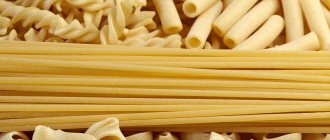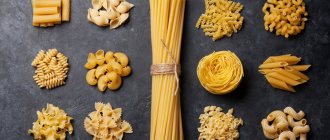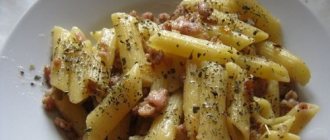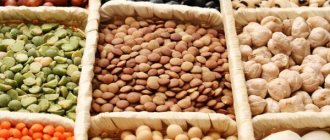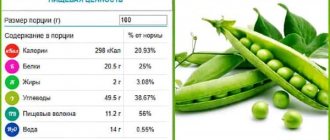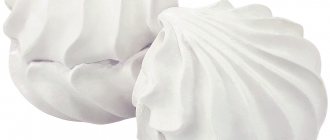Calorie content of durum wheat spaghetti per 100 grams is 352 kcal. In a 100-gram serving of such flour products:
- 13 g protein;
- 1.5 g fat;
- 70.2 g carbohydrates.
To produce high-quality spaghetti, a minimum set of ingredients is used. The main components of the product are water and durum wheat flour. The vitamin and mineral composition of spaghetti is represented by vitamins B1, PP, minerals copper, phosphorus, molybdenum, manganese, cobalt, selenium.
Calorie content of buckwheat spaghetti per 100 grams
Calorie content of buckwheat spaghetti per 100 grams is 337 kcal. In a 100-gram serving of such products:
- 6.3 g protein;
- 1 g fat;
- 77 g carbohydrates.
Read: Roll with salmon: calorie content per 100 grams
Buckwheat spaghetti is rich in phosphorus, thiamine, selenium, magnesium, and lecithin. With regular consumption of the product, cholesterol levels in the blood are reduced and digestion is improved (spaghetti made from buckwheat flour is enriched with dietary fiber, which removes toxins and waste from the body).
Barilla spaghetti carbonara pasta
One of the most popular pasta recipes. A delicate cheese sauce harmonizes with pasta, and aromatic crispy bacon adds piquancy to the dish. Pasta carbonara can be prepared for lunch or dinner.
Cooking time: 20 minutes.
Ingredients:
- spaghetti – 250 gr;
- Parmesan cheese – 70 gr;
- bacon or pancetta – 150 g;
- egg – 1 piece;
- olive oil – 20 ml;
- butter – 40 g;
- pepper;
- salt;
- garlic.
Preparation:
- Place a pot of water on the fire, add salt to taste and stir. Place the spaghetti in the pan, wait until the pasta settles and is completely submerged in water. Stir and cook for 8 minutes until al dente.
- Place a frying pan on the stove and pour in olive oil. Place butter in a heated frying pan and melt.
- Cut the bacon into cubes or square slices.
- Peel the garlic and press down with the flat side of the knife.
- Fry the bacon and garlic in oil for a few minutes.
- Separate the egg into white and yolk.
- Grate the cheese on a fine grater and add to the yolk. Add salt and pepper, mix thoroughly.
- Remove garlic from pan.
- Add spaghetti to bacon.
- Turn off the heat, pour in the cheese-yolk mixture and 2 tablespoons of water from the pan in which the pasta was cooked.
- Mix all ingredients and leave covered for 2 minutes.
- When serving, garnish a serving of pasta with grated cheese.
The benefits of spaghetti
High-quality spaghetti made from durum wheat can bring considerable benefits to the body. The beneficial properties of this product include:
- spaghetti is saturated with selenium, which has a pronounced antioxidant effect;
- Regular consumption of spaghetti ensures that the body maintains a normal level of manganese, which improves the metabolism of carbohydrates and maintains normal sugar levels;
- inclusion of this product in the diet reduces the risk of developing heart and vascular diseases and helps lower the level of bad cholesterol;
- spaghetti is rich in vitamins and minerals necessary to maintain a healthy nervous system;
- the product has a relatively low calorie content, therefore it is indicated for inclusion in the diet for many diets;
- Spaghetti amino acids stimulate the production of serotonin, a hormone responsible for healthy sleep and excellent mood.
Cannelloni with minced beef and Bechamel sauce
A popular dish in Italy, stuffed cannelloni will appeal to lovers of dumplings and lasagna. Rich in flavor, classic Italian sauce, a hearty and tasty dish that cooks quickly and requires few ingredients. The dish can be prepared for lunch or dinner, or served as an original dish on a holiday table.
It takes 50-60 minutes to prepare the dish.
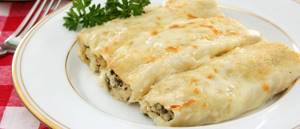
Ingredients:
- cannelloni – 150 g;
- minced beef – 400 g;
- vegetable oil – 2 tbsp. l.;
- Parmesan cheese – 100 gr;
- onion – 1 piece;
- garlic – 1 clove;
- tomato juice – 200 ml;
- ground black pepper;
- salt;
- Italian herbs;
- butter – 50 g;
- milk – 1 l;
- nutmeg – 1 tsp;
- flour - 3 tbsp. l.
Preparation:
- Finely chop the onion and garlic and fry in a frying pan in vegetable oil until transparent.
- Add minced meat to the pan, stir and fry with garlic and onion for 7 minutes.
- Pour tomato juice into the pan. Mix the ingredients and simmer the minced meat under the lid for 15 minutes. Open the pan and evaporate excess liquid.
- Salt, pepper and season the minced meat with Italian herbs. Stir and leave to cool.
- Stuff the cannelloni tightly with minced meat.
- Prepare Bechamel sauce. Melt 30 grams in a saucepan. butter, add flour, mix. Heat the milk in a separate pan. Slowly pour milk, 100 ml at a time, into the pan with butter and flour. Stir constantly to prevent lumps from forming. Add salt, pepper and seasoning to the sauce. Stir, bring to a boil and simmer the sauce for 3 minutes over low heat. Put 20 grams into the sauce. butter.
- Grate the cheese on a fine grater.
- Pour half the sauce into the baking dish.
- Place the cannelloni.
- Pour the remaining sauce over the cannelloni.
- Place a layer of grated cheese on top.
- Bake the cannelloni for 30-35 minutes at 180 degrees.
Pasta diet for a slim figure
If we limit ourselves to these flour products without adding spices and sauces to them, then their calorie content allows us to consider this dish a dietary one. They are a source of large amounts of carbohydrates, so it is advisable to consume them before four o’clock in the afternoon, when our metabolism is at its peak.
Towards evening, the metabolic rate decreases significantly, which is why it is recommended to have dinner with protein-rich dishes and avoid high-carbohydrate foods. The body is not able to fully process carbohydrates received in the evening, and therefore it immediately “preserves” them in fat deposits.
- It is important to follow the rules of separate nutrition, according to which pasta should not be consumed together with meat products or fats (which include, in particular, cheese).
- In tandem with vegetables and mushrooms, pasta is perfectly absorbed by the body. From this point of view, the ideal dish would be a casserole of eggs, pasta, fresh bell pepper and cauliflower. The average calorie content of such a dish, which is suitable for breakfast, is about 140 kcal per 100 grams.
- Pasta with fresh vegetable salads is also recommended because it accelerates the process of burning fat cells and stimulates the normalization of metabolism. This means that the pasta dish is absorbed by the body faster and better.
- Don't be afraid to season them with hot spices (even black pepper, despite its high calorie content), as they speed up metabolism. Pasta additives such as garlic and mustard also work for this purpose.
- But try to reduce your salt intake, because it greatly inhibits water metabolism in the body, which leads to excess weight, as well as the appearance of swelling.
In order not to harm your figure, you should not indulge yourself with pasta every day, but you can eat such dishes twice a week. Although even a complete pasta diet has already been developed, suggesting that in one month of following it it is possible to lose five kilograms.
This regime assumes that a person can eat no more than three hundred grams of these tasty products per day (the indicated weight assumes the mass of the dry product). You won’t have to go hungry on such a diet, since spaghetti is quite nutritious even without various additives.
For dietary nutrition, spaghetti should be cooked with a spoonful of olive oil added to the water. But you cannot add oil or sauces to prepared pasta. If desired, hot spaghetti can be topped with egg white.
Also, the menu should be supplemented with lean varieties of meat and fish - up to one hundred grams per day. You can also drink a liter of low-fat kefir and eat about two hundred grams of cottage cheese per day. Make sure you consume no more than 1,300 kilocalories daily.
To enhance the effect of the diet, you need to regularly engage in some type of physical activity!
Another constant requirement is maintaining water balance, for which you need to drink one and a half to two liters of water daily. But don't be afraid of such a quantity. According to the World Health Organization, these two liters account for all the liquid consumed by a person throughout the day.
In the case of a diet, in addition to water, you can drink green tea without sugar or herbal decoctions. Also count them in these two liters, and take the remaining amount with clean still water.
Due to poor nutrition, it is better to drink a vitamin complex at the same time. You cannot follow this diet for more than a month. Since it is a type of strict diet, it is not recommended to resort to it more than once every six months.
Pasta calorie table
The average ranges from 320 to 350 kcal per 100 grams of dry product. But this figure varies depending on the type of product and its type. The easiest way is to present the calorie content of pasta in a table indicating the BJU for each specific variety:
| Types of pasta | Calories (kcal) | Proteins (g) | Fats (g) | Carbohydrates (g) |
| Whole grain Makfa | 361 | 13,9 | 1,4 | 73,1 |
| Barilla | 353 | 12,0 | 2,0 | 71,7 |
| Noodles Rollton | 448 | 8,8 | 20,7 | 56,7 |
| Milk pasta | 345 | 11,5 | 2,9 | 67,1 |
| Vermicelli Myllyn Paras | 344 | 10,4 | 1,1 | 71,5 |
| Premium pasta | 337 | 10,4 | 1,1 | 69,7 |
| 1st grade | 335 | 10,7 | 1,3 | 68,4 |
| Egg | 345 | 11,3 | 2,1 | 68 |
| Penne All Arabiata | 160 | 4,6 | 3,9 | 26,7 |
| Vermicelli Mivina | 393 | 7,7 | 18,9 | 50 |
| Shebekinsky | 350 | 13 | 1,5 | 72 |
The calorie content of rice and buckwheat noodles deserves special attention, since these products also belong to the category of pasta. How many calories are in buckwheat? This variety “weighs” 348 kcal, and the rice version weighs 344 kcal.

Photo source: shutterstock.com
Here are just the main varieties with energy value per 100 grams. However, the calorie content of raw semi-finished products is indicated here. After cooking, these numbers are usually reduced by 2.5-3 times. What explains this? It's simple: during the cooking process, the products swell and become larger. Therefore, the energy value of 100 grams of ready-made pasta and 100 grams of dry pasta are radically different.
ABC RECOMMENDS

Calorie content of buckwheat (in water, with oil, with salt) per 100 grams
How many calories are in prepared pasta: with butter, cheese, egg, fried
The energy value of the finished product depends on the cooking method. For example, 100 grams of boiled pasta contains 112 kcal. But there is no such fundamental difference between dry and boiled spaghetti, since during the cooking process they do not increase in volume so much. Therefore, with a starting 330 kcal, the boiled dish will contain about 220 units (1 standard serving without oil). The same story with vermicelli. Therefore, if in dry form it contains about 370 calories, then after boiling the figure will be up to 190 kcal.
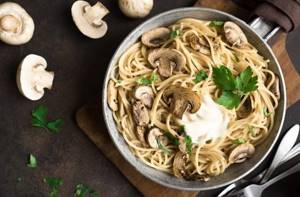
Photo source: shutterstock.com
When including pasta in your menu, it is important to understand: most of the calories are not found in products cooked in water. The high calorie content of the dish is created by sauces, gravies and other additives with which they are usually served.
Buckwheat noodles, which weigh quite a lot when dry, give only 150 kcal after cooking.
One of the most common additives is oil. By adding butter, the energy value of pasta reaches 160 kcal per 100 g. But pasta with cheese “weighs” quite a lot. For the same amount, calorie content increases to 330 units.

Photo source: shutterstock.com
Many people can’t resist fried navy pasta. But just 1 serving is 330 kcal. Fried dough products without adding other ingredients - 176 units. Baked with egg - 152 calories, lasagna with vegetables - 212, and pasta with seafood (risotto sea) - 104.
You can find out what pasta you are allowed to eat during the diet from the video:

